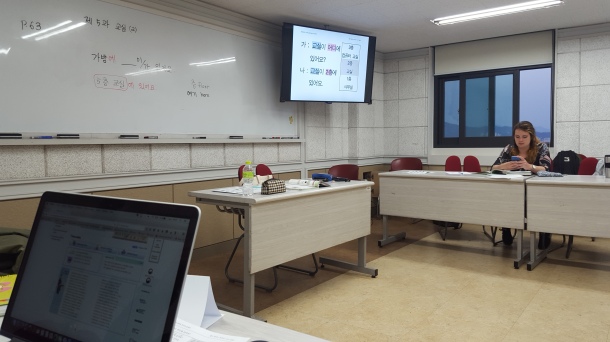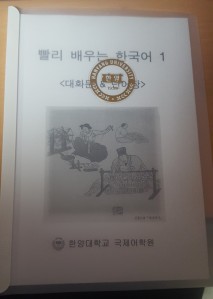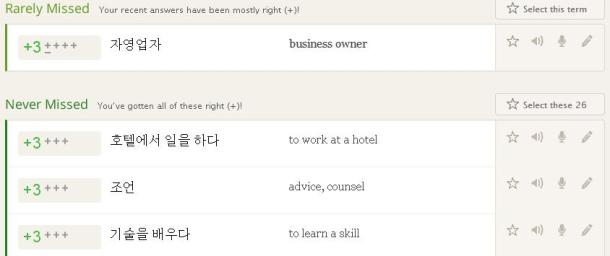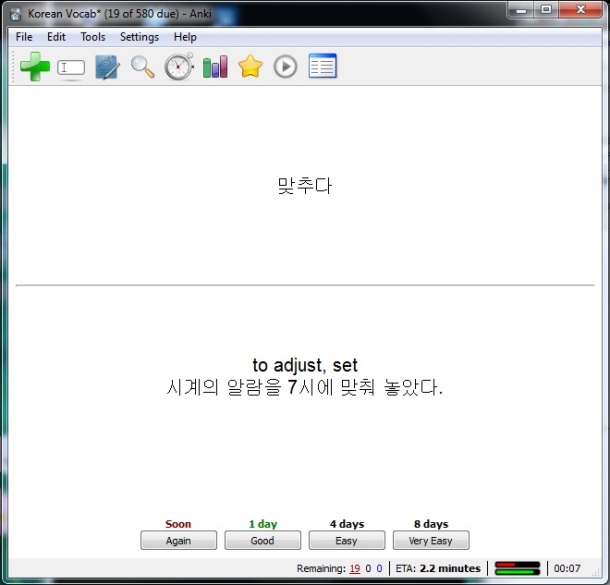If you’re coming to Korea without any experience in the Korean language, fear not! Hanyang University offers Korean language classes to its exchange students. There are two types of classes are offered by the university: Intensive Korean, which focuses on immersing students in Korean, and Survival Korean, which focuses on giving students a basic understanding that will be sufficient for getting around Korea as a tourist. The biggest difference between these two classes is that Intensive Korean takes place for 4 hours every session from Monday through Thursday, while Survival Korean only takes place two days during the week for 2 hours. Because of this Intensive Korean can be taken for 12 credit hours while Survival Korean is only 3 credit hours.
Many students, myself included, choose to take Survival Korean. The approach is remarkably similar to that of Intensive Korean: the teacher speaks almost no English to the students from the very beginning. With this being said, the Survival Korean instructor may be a bit more lenient in order to explain grammar concepts or the finer points of Korean to students. You can also find this approach in the textbook: directions and new vocabulary are not given in English. You must learn to associate the word with an image or idea, not the equivalent in your language. This seems to be for two reasons. The first is because there are students from around the world, so giving vocabulary in English may make the class much more difficult. The second reason is because research suggests this is the most effective way to learn a language. It is similar to how young children learn language.
The structure of Survival Korean is very laidback. The class usually begins a review of previous the previous lesson. After this new vocabulary and grammar points are introduced. Then a short break is given, and after the break the teacher continues into new vocabulary. Throughout the class, speaking and listening exercises are given to practice the new words and vocabulary. Repetition seems to be the most important part of the class. Immediately after the teacher has introduced new vocabulary or grammar, she will ask the students to repeat the words that she says. This is repetition ensures that students are pronouncing words the correct way and using the correct grammar.

There are only two required materials for Survival Korean which are pictured below. The green book can be purchased at the Hanyang Bookstore, and the white booklet is a workbook can only be purchased through the language office when the class initially starts.


There are also a few resources I’d recommend that have helped me in the past with my learning endeavors. The first tool is Quizlet. When I was studying another language in the U.S., I could always count on Quizlet to help me study vocab. It’s free, and very easy to use on both a computer and phone. You can also play games that test your knowledge of the cards that you’ve placed. The next tool, Anki, is something that I used to memorize terms for some of my business classes. It uses a special system that spaces out the time you see a word again. This means that words that you are better at remembering at appear less frequently than words that you can’t recall as well. I’ve read that this is a popular way for people learning new languages to teach themselves vocabulary, and my previous experience with Anki is very good!

Tool 1: Quizlet
https://koreasquirrel.files.wordpress.com/2014/12/quizlet-rarelymssed.jpg

Tool 2: Anki
https://sydneytoseoul.files.wordpress.com/2012/08/anki.jpg
Article by Eli from the U.S.A.
Leave a comment